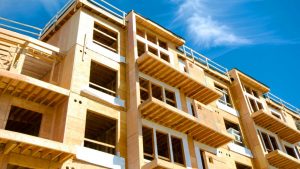Academic study of the environmental impact of steel and concrete including GHGs has been rigorous and with good reason. These materials are ubiquitous on construction sites around the world.
Many view mass timber as the answer to construction’s carbon emission woes. A single mature tree can absorb nearly 50 pounds of CO2 from the atmosphere each year. Since that carbon is collected and embodied over several years, putting wood to use in mass timber construction (MTC) components appears to make sense.
As MTC becomes increasingly popular in non-residential construction, its full carbon consequences are receiving a higher level of examination.
Two recent independent studies attempt take a close look at MTC. Both end up with generally positive conclusions.
A 2019 U.S. study compared an MTC building (what the authors call a Cross Laminated Timber or CLT building) to both a hybrid MTC/concrete and a concrete building with “similar functional characteristics.” The authors evaluated the embodied emissions and energy associated with building materials, manufacturing and construction of each.
“The results of this study reveal that replacing concrete and steel with CLT in the building structure can present significant environmental benefits. The major environmental benefits include an average of 26.5 per cent reduction in global warming potential, a 30 per cent reduction in eutrophication potential and a 25 per cent reduction in depletion potential of the stratospheric ozone layer for cradle-to-gate analysis.”
The hybrid concrete/MTC building had similar results.
However, there were some caveats and details that are important to note.
The authors point out CLT involves “at least three times more wood material than is common with light framed construction, with added processing and auxiliary materials such as adhesives to create a solid panel.”
Secondly, they concede “the extent to which the greater wood quantity and adhesives use will influence the overall LCA is not well established.”
Thirdly, the study neither quantified any differences resulting from local or long-distance sourcing of the wood used for the CLT building components nor considered forest management practices.
A 2021 comparative building study conducted in China came to much the same overall conclusion.
“The results show that the timber building achieved a 25 per cent reduction in global warming potential compared to its concrete counterpart.”
The Chinese study also pointed out the four-inch thick mass timber panels delivered an insulation contribution of R5, something not achieved by concrete. It also acknowledged less concrete and rebar was required in those structural elements requiring their use.
Unfortunately, neither study offered a full cradle-gate-grave analysis of mass timber, particularly lumber extraction techniques and any end-of-life use of MTC.
However, unlike the U.S. study, the Chinese paper did consider distances between sources and jobsites. It acknowledged the concrete had some advantages due to local sourcing while the wood used in the MTC modelling was assumed to travel over 2,000 kilometres.
“Longer transportation distances of the raw material can post significant environmental and economic burdens and undermine the potential of using wood products. Using locally sourced wood would require changes in forest management policies,” it said.
It leaves the door open to further questions.
A recent article in the Economist suggested higher timber prices resulting from increased demand could increase net land-use emissions by accelerating harvests in natural forests. On the other hand, higher prices could encourage the wood harvesting industry to increase investment in more intensive forest management.
One answer, the article said, is for mass timber production to evolve away from using high grade lumber.
Instead, it should develop processes “that can handle small-diameter, lower-grade logs from thinning operations that promote health in overstocked forests that are vulnerable to fire or disease.”
Sourcing mass timber from lower-grade wood may improve carbon sequestration by promoting forest restoration.
Clearly more study is required.
Writing in a Yale University publication, Jim Foster concludes, “There are key questions about the life cycle of mass timber, and some say the industry doesn’t have enough data yet to back up its claim that it is a major climate change solution.”
John Bleasby is a Coldwater, Ont.-based freelance writer. Send comments and Climate and Construction column ideas to editor@dailycommercialnews.com.








Recent Comments
comments for this post are closed